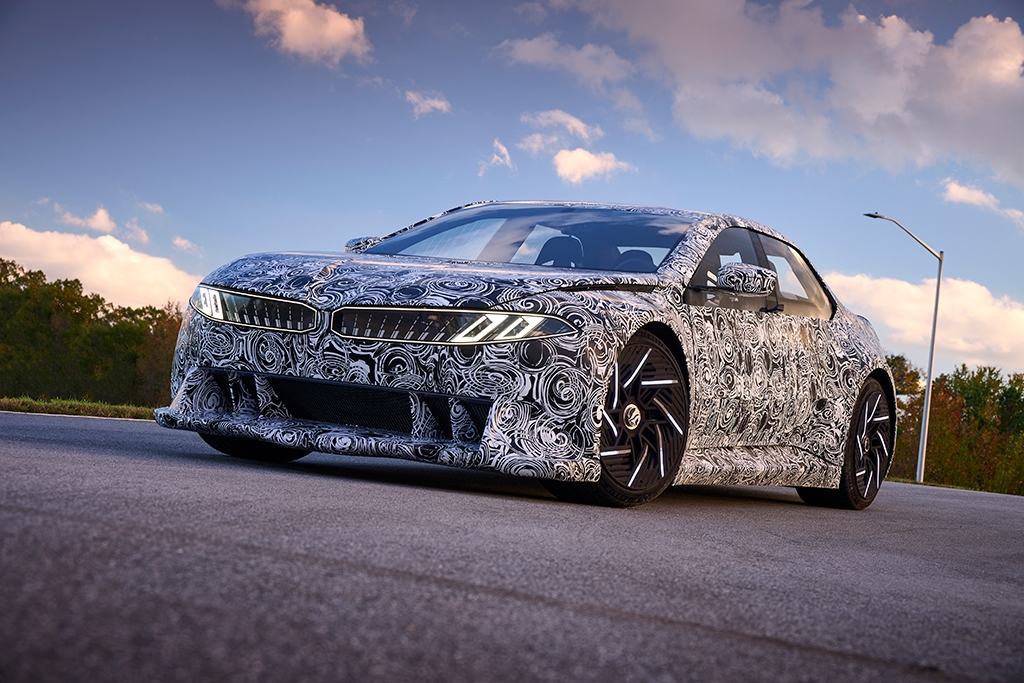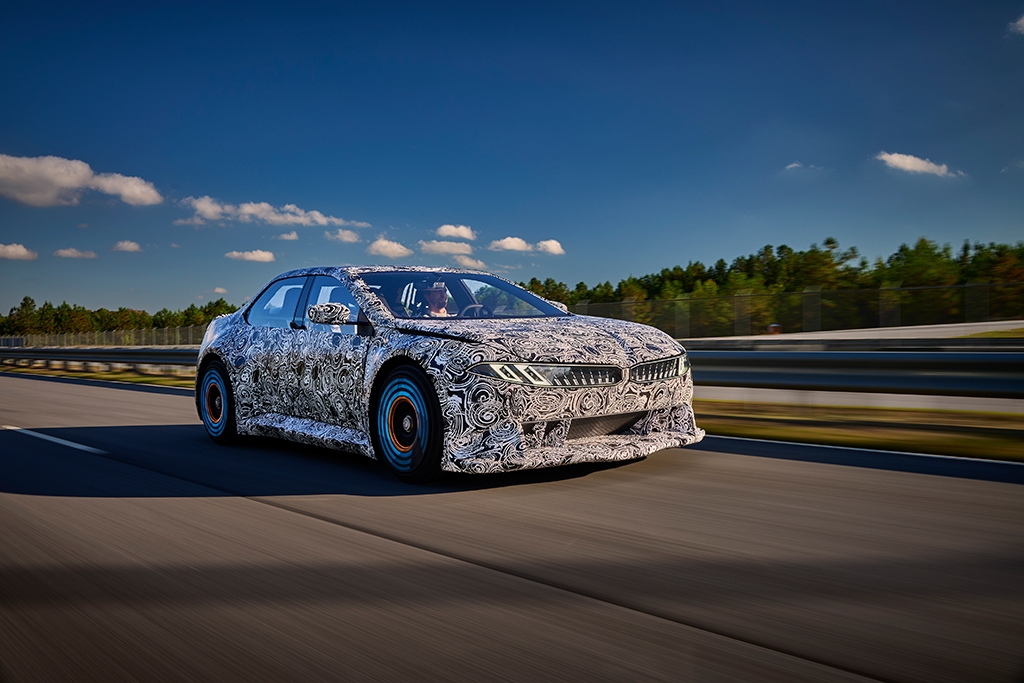BMW re-emphasises driving pleasure with new Heart of Joy ECU
11 Mar 2025|495 views
When the first electric Neue Klasse car debuts at the end of 2025, German luxury carmaker BMW will make a decisive leap into its next era of electrification. Still, it wants the automotive world to know that it is staying true to its longstanding roots: Of emphasising driving pleasure like no other name in the market.
Its secret weapon in achieving that? A new control unit passionately dubbed the 'Heart of Joy', no larger than the size of two or three iPads pressed together. (In press materials, BMW has officially referred to it as a "small black box").
Developed fully in-house, and thus also fully owned and controlled by BMW, it will make its series production debut on the first Neue Klasse car (all but confirmed at this point to be the all-new iX3). Prior to that, BMW has already shown off the full extent of its capabilities 'rolling lab'-style, at its BMW Performance Driving Centre in Spartanburg via an endurance test with a prototype vehicle (named the 'Vision Vehicle').
It’s worth noting that whatever BMW had teased about its new Neue Klasse before this fuller reveal of the Heart of Joy had been centred on three main pillars: 'Electrical', 'digital', and 'circular'. As mentioned earlier, however, this latest development sees the brand reminding us that it hasn't lost sight of the hallmark 'Sheer Driving Pleasure' quality that has defined its cars for decades - even as the world shifts increasingly electric.
BMW states that the Heart of Joy can process information a good 10 times faster than the previous generation system used thus far on existing models. And as for what information it's been designed to process, it will seamlessly integrate controls not just for the drivetrain, but also the brakes (and recuperation), steering subfunctions, and even charging in its impending production vehicles.
With drivetrain and driving dynamics functions effectively combined for the first time by the brand, the intended result is an unprecedented level of mastery over how a vehicle performs. Conventional systems, for instance, see separate control algorithms for the drive system and brakes. By combining them within the same software stack now, BMW states that it's managed to minimise lag and more closely embed functions that have been thus far been more disparate.
One example of the sheer amount of power the vehicle can deal with is the amount of peak torque developed by the Vision Vehicle: A whopping 18,000Nm. That’s far above what BMW’s most potent M Performance electric cars can muster today.
Of course, expecting performance of this level to trickle down to road going production cars is unrealistic - and indeed, BMW has already confirmed that the Vision Vehicle as currently iterated will not be entering production. Still, the reasoning behind the endurance test stands that the demands of everyday driving will pale - and be handled with effortless ease - against what a car capable of 18,000Nm of torque tasks the Heart of Joy with processing.
Another tangible benefit is the fact that fewer control inputs are required under highly dynamic driving, even as the vehicle remains un-intimidating within less taxing situations.
Sgcarmart took a ride in the Vision Experience car in Spartanburg late last year with racing driver Jens Klinsmann at the helm, and witnessed firsthand as he pushed the Vision Vehicle to its limit around the test track, threaded it around sharp hairpins, and gunned it at stomach-churning pace down longer straights - all with dramatic effortlessness.
Likewise, the prototype vehicle was smooth and easy to control at lower speeds, when shuttling media to and from the test track to a garage offsite.
Performance aside, the Heart of Joy promises better efficiency than on past electric BMWs, with the brand boldly proffering that the braking power generated using energy recuperation will suffice for normal everyday driving. (Only under heavy braking - in emergencies, for instance - should the friction brakes come into play.) Efficiency levels are expected to rise by approximately 25% as a result.
With seamless control ostensibly shaping up to be a key focus for BMW moving forward, the Heart of Joy will not stand alone within the architecture used within the Neue Klasse.
BMW has stated that it will work alongside three other "super-brains" to fully realise the intended capabilities of its next-generation models, responsible for automated and semi-automated driving, the car's infotainment system, and basic functions such as climate control and comfort-enhancing systems, vehicle access, interior and exterior lighting.
When the first electric Neue Klasse car debuts at the end of 2025, German luxury carmaker BMW will make a decisive leap into its next era of electrification. Still, it wants the automotive world to know that it is staying true to its longstanding roots: Of emphasising driving pleasure like no other name in the market.
Its secret weapon in achieving that? A new control unit passionately dubbed the 'Heart of Joy', no larger than the size of two or three iPads pressed together. (In press materials, BMW has officially referred to it as a "small black box").
Developed fully in-house, and thus also fully owned and controlled by BMW, it will make its series production debut on the first Neue Klasse car (all but confirmed at this point to be the all-new iX3). Prior to that, BMW has already shown off the full extent of its capabilities 'rolling lab'-style, at its BMW Performance Driving Centre in Spartanburg via an endurance test with a prototype vehicle (named the 'Vision Vehicle').
It’s worth noting that whatever BMW had teased about its new Neue Klasse before this fuller reveal of the Heart of Joy had been centred on three main pillars: 'Electrical', 'digital', and 'circular'. As mentioned earlier, however, this latest development sees the brand reminding us that it hasn't lost sight of the hallmark 'Sheer Driving Pleasure' quality that has defined its cars for decades - even as the world shifts increasingly electric.
BMW states that the Heart of Joy can process information a good 10 times faster than the previous generation system used thus far on existing models. And as for what information it's been designed to process, it will seamlessly integrate controls not just for the drivetrain, but also the brakes (and recuperation), steering subfunctions, and even charging in its impending production vehicles.
With drivetrain and driving dynamics functions effectively combined for the first time by the brand, the intended result is an unprecedented level of mastery over how a vehicle performs. Conventional systems, for instance, see separate control algorithms for the drive system and brakes. By combining them within the same software stack now, BMW states that it's managed to minimise lag and more closely embed functions that have been thus far been more disparate.
One example of the sheer amount of power the vehicle can deal with is the amount of peak torque developed by the Vision Vehicle: A whopping 18,000Nm. That’s far above what BMW’s most potent M Performance electric cars can muster today.
Of course, expecting performance of this level to trickle down to road going production cars is unrealistic - and indeed, BMW has already confirmed that the Vision Vehicle as currently iterated will not be entering production. Still, the reasoning behind the endurance test stands that the demands of everyday driving will pale - and be handled with effortless ease - against what a car capable of 18,000Nm of torque tasks the Heart of Joy with processing.
Another tangible benefit is the fact that fewer control inputs are required under highly dynamic driving, even as the vehicle remains un-intimidating within less taxing situations.
Sgcarmart took a ride in the Vision Experience car in Spartanburg late last year with racing driver Jens Klinsmann at the helm, and witnessed firsthand as he pushed the Vision Vehicle to its limit around the test track, threaded it around sharp hairpins, and gunned it at stomach-churning pace down longer straights - all with dramatic effortlessness.
Likewise, the prototype vehicle was smooth and easy to control at lower speeds, when shuttling media to and from the test track to a garage offsite.
Performance aside, the Heart of Joy promises better efficiency than on past electric BMWs, with the brand boldly proffering that the braking power generated using energy recuperation will suffice for normal everyday driving. (Only under heavy braking - in emergencies, for instance - should the friction brakes come into play.) Efficiency levels are expected to rise by approximately 25% as a result.
With seamless control ostensibly shaping up to be a key focus for BMW moving forward, the Heart of Joy will not stand alone within the architecture used within the Neue Klasse.
BMW has stated that it will work alongside three other "super-brains" to fully realise the intended capabilities of its next-generation models, responsible for automated and semi-automated driving, the car's infotainment system, and basic functions such as climate control and comfort-enhancing systems, vehicle access, interior and exterior lighting.
Latest COE Prices
November 2025 | 2nd BIDDING
NEXT TENDER: 03 Dec 2025
CAT A$109,000
CAT B$129,890
CAT C$76,389
CAT E$125,001
View Full Results Thank You For Your Subscription.




























